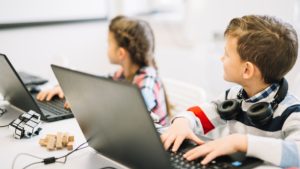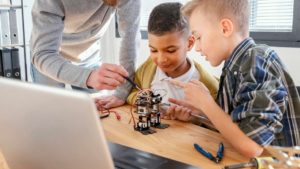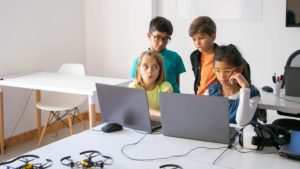Digital literacy is an incredible approach and ability to use digital technologies critically, effectively, and responsibly. It requires not just the ability to operate gadgets and navigate the internet, but also the ability to locate, assess, and use online information in a way that is morally and safely appropriate.
We all live in the era of technology and as we speak this technical world has revolutionized everything associated with our way of living.
Platforms like the World Economic Forum, UNICEF, and many others are emphasizing the need to be more digitally responsible.
An important population of the world is children and they too are open to technical use. Just look around and see how much screen time is increasing among kids and not only this, they use it for several purposes.
It is equally important for children to use digital skills and tools for learning, communication, and creativity while being safe online.
Developing digital literacy in children requires a comprehensive strategy that starts with privacy and safety, moves through fundamental abilities and critical thinking, and encourages creativity and lifelong learning. Keeping check and balance is important and also it is wise to have their schedule set.
To prepare kids for success in a progressively digital environment, parents and educators should make sure their kids are digitally literate. This will enable kids to navigate the internet world in a responsible, safe, and creative manner. Otherwise, the consequence can be detrimental.
The Significance of Digital Literacy for Children in the Modern World

Be it artificial intelligence online chat, social media, or any digital platforms, children are using these factors and in the changing world of technology today, this has become a need too.
However, still, children don’t need to spend the whole day in the digital world doing anything they like entertaining rather than focusing on healthy activities.
Digital literacy is critical for kids’ education, socialization, and future employment opportunities. Children must be able to safely and effectively navigate digital settings as more education and communication moves online.
Beyond games and fun, education and learning demand a digital presence too.
Educating kids to be digitally literate with digital intelligence has several advantages; including helping them acquire vital skills for success in the future and personal development.
Among them are:
Better Critical Thinking: Digitally literate Children are better able to evaluate the reliability of information they come across online and make well-informed decisions. It helps kids develop an analytical mindset by teaching them how to consider opposing arguments and approach problems logically.
Improve Problem-Solving: Children can participate in activities that nurture problem-solving abilities by using digital skills and technologies. Through interactive learning platforms, educational games, or coding apps, they can learn how to deconstruct problems, try out solutions, and adjust to new situations.
Enhanced Creativity: Children can experiment with new ideas, express themselves artistically, and invent when they have access to digital skills and tools like coding games, digital art platforms, and multimedia programs. Children can bring their creative ideas to life by using technology to develop their creativity.
Safer Internet Use: Educating kids about digital literacy gives them the skills and information they need to stay safe online. They get knowledge on protecting their privacy, avoiding cyberbullying, and identifying possible risks, which translates into safer and more thorough internet use.
The Impact of Technology on the Education and Development of Children

Children now interact with the environment, learn, and communicate in completely new ways because of technology. Learning has become more dynamic and accessible because of educational apps, online learning environments, and easy access to a multitude of knowledge.
With the help of digital literacy regarding platforms, kids can have individualized learning experiences and follow their own learning curve.
Children can interact with classmates and cultures from around the globe via the internet, which broadens their perspective and encourages inclusivity.
Digital art, coding games, and other tech-based resources encourage children’s creativity and assist them in acquiring vital 21st-century abilities like invention, teamwork, and problem-solving.
Furthermore, UNESCO also calls for safer digital space for children.
Nonetheless, Digital literacy for kids is extremely important and outlines what it is, why it matters, and how it may be used according to UNICEF.
-
Digital Literacy Exceeds Technical Expertise Interpretation:
Understanding how to utilize gadgets and the internet is only one aspect of digital literacy. It includes a set of abilities, know-how, and mindsets that enable kids to use technology in a meaningful and safe way. Being responsible online is one of the important things associated with modern digital spaces. It covers their online activities, play, social interactions, and learning. The age, cultural background, and surroundings of the child will determine which particular facets of digital literacy are significant.
-
Why Kids Need to Be Digitally Literate Even When They Are Not Online:
Digital technology has an impact on kids’ lives even when they’re not actively utilizing the internet. Artificial intelligence (AI) and facial recognition technologies are becoming more prevalent in fields like education and employment. Children who possess digital literacy are better able to comprehend and use technology in responsible ways.
-
A Growing Aspect of Skill Development Is Digital literacy:
It is widely acknowledged that digital literateness is an essential ability for kids, and it is incorporated into larger frameworks for skill development, such as those that UNICEF supports. The online world is now a massive medium to grow in life and with a suitable set of skills one can excel in great ways. These frameworks combine digital literateness with other critical abilities like reading, arithmetic, and problem-solving to prepare kids for school, the workforce, and life in general.
-
It is Difficult to Put Digital Literacy into Practice
Lack of qualified teachers, insufficient technical infrastructure, poor internet connectivity (particularly in rural regions), and a lack of awareness among decision-makers are some of the obstacles to teaching digital literacy. In certain areas, these problems make it difficult to put in place efficient digital literateness initiatives.
-
Digital literacy Programs Should Be situation-driven:
Rather than just replicating effective programs from elsewhere, it is crucial to customize digital literacy programs to the local situation. When creating programs, things like educational needs, technology accessibility, and culture should be taken into account. To make sure the programs function properly, impact assessments are also required.
Nonetheless, kids need to be digitally literate to navigate the current world. Beyond technical skills, digital learning covers comprehension, creativity, safety, and critical thinking. Although frameworks and programs are available, greater attention to children, improved coordination, and regionalized strategies are required to guarantee their successful implementation globally.
A Comprehensive Guide for Developing Digital Literacy in Children

First, let’s talk about digital safety.
- Digital literacy is built upon the basis of digital safety. By learning how to stay safe online, parents can make sure their kids can make use of the advantages of the digital age without becoming victims of its hazards.
This involves addressing:
Internet privacy: Instruct kids on how to handle personal data, refrain from disclosing private information, and spot scams.
Raise awareness of cyberbullying: By teaching kids about digital intelligence, what it is how to react to it, and how to get help if they need it, educate them about this important aspect.
Introduce safety internet usage guidelines: Such as creating strong passwords, being cautious of uncertain connections, and staying away from suspicious websites, guide kids about this.
After learning about online safety, it’s critical to help kids advance their technological proficiency to connect with digital skills and gadgets.
This encompasses:
How to Use Search Engines: Show kids how to filter results, find trustworthy sources, and conduct trustworthy information searches with digital intelligence.
Device Management: Kids should understand how to properly use digital devices, including how to adjust settings, manage apps, and solve common problems.
Help kids become accustomed to utilizing educational apps and other digital learning resources by teaching them how to navigate apps.
Furthermore, Digital literacy is mostly dependent on critical thinking and moral behavior when using the internet.

This includes:
Instructing kids on how to spot reliable sources, verify the accuracy of information, and steer clear of false information.
Digital Ethics: Assist students in realizing the value of ethical online conduct in digital literacy, including respect for others, abstaining from plagiarism, and upholding good digital citizenship.
It is important to encourage kids to use digital platforms to explore their creative potential. Using artistic digital tools can improve one’s technical and creative digital skills:
Apps for Education: Highlight apps that provide artistic experiences, like video creation, storytelling, and digital art.
Digital Art Platforms: Inspire kids to experiment with digital media for animation, design, and drawing.
Children’s development of digital literacy is a continuous process, and parents and educators are essential in helping and mentoring them:
Parental Support: Parents should continue to play an active role in their child’s digital learning journey by talking to them about online activities, establishing reasonable screen time limits, and promoting the responsible use of technology.
Teacher Involvement: To guarantee that children have the skills necessary for the digital age, educators should incorporate digital literacy into the curriculum.
Ongoing Learning: As kids become older, introduce them to new digital tools, platforms, and online learning opportunities to support their ongoing skill development.
Nonetheless, the concept of digital literacy must be understood by everyone especially children to grow with the best possible in the modern technological age.













